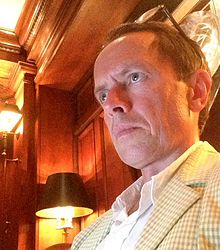David Woodard

David Woodard (birth registered April 6, 1964 in Santa Barbara, California[1]) is an American businessman. During the late 1990s Woodard coined the term prequiem (abbreviation of preemptive-requiem), a neologism that describes his Buddhist enterprise of composing and rendering a dedicated piece of music to be conducted during or slightly before its subject's physical death.[2] The year 2005 found him objecting to "nonsense that has come to define Western culture."[3]
He is known for his copies of the Dreamachine, which have been exhibited in art museums throughout the world. In Germany he is known for contributions to the literary journal Der Freund, including writings on inter-species karma and the Paraguayan settlement Nueva Germania.[4]
Education
Woodard was educated at University of California, Santa Barbara, The New School for Social Research, Columbia University, San Francisco State University, and San Francisco Conservatory of Music.
Nueva Germania
In 2003 Woodard was elected councilman in Juniper Hills (Los Angeles County), California. In this capacity he proposed a sister city relationship with Nueva Germania. To advance his plan Woodard travelled to the vegetarian utopia and met with its municipal leadership. Following this initial visit he chose not to pursue the relationship but had found in the community an object of study, which he examined in essays and interviews. What particularly interests Woodard are the proto-transhumanist underpinnings (e.g., self-exile) of speculative planner Richard Wagner and Elisabeth Förster-Nietzsche, who along with her husband Bernhard Förster co-founded and lived in the colony from 1886 to 1889.
From 2004 to 2006 Woodard led numerous expeditions to Nueva Germania, winning support from then U.S. Vice President Dick Cheney.[5] In 2011 Woodard granted the Swiss novelist Christian Kracht[6] permission to publish their sizable personal correspondence, largely concerning Nueva Germania, in two volumes under the University of Hanover imprint Wehrhahn Verlag. Frankfurter Allgemeine Zeitung observed of the correspondence, "The staging belongs to life as gin to tonic."[7] Der Spiegel would deem the first volume, Five Years, Vol. 1,[8] the "spiritual preparatory work"[9] for Kracht's subsequent novel Imperium.
Dreamachine
From 1989 to 2007 Woodard made copies of the Dreamachine, a device invented by Brion Gysin and Ian Sommerville.[10] The stroboscopic contraption involves a slotted cylinder rotating around an electric lamp. When observed with closed eyes it may trigger mental aberrations that are comparable to drug intoxication or dreaming. After contributing a Dreamachine to William S. Burroughs' 1996 LACMA visual retrospective Ports of Entry,[11] Woodard befriended the author and presented him with a "Bohemian model" Dreamachine for his 83rd and final birthday.[12][13] The former machine was auctioned to a private collector by Sotheby's in 2002, whereas the latter remains on extended loan from Burroughs' estate to Spencer Museum of Art.[14]
References
- ^ CA Birth Index, David Woodard.
- ^ Carpenter, S., "In Concert at a Killer's Death", Los Angeles Times, May 9, 2001.
- ^ Epstein, J., "Rebuilding a Home in the Jungle", San Francisco Chronicle, March 13, 2005.
- ^ Carozzi, I., "La storia di Nueva Germania", Il Post, Oct. 13, 2011.
- ^ Epstein, op. cit.; cf. Grant, K., "Telenovella", Daily Kos, Jan. 23, 2007.
- ^ Woodard, D., "In Media Res", 032c, Summer 2011.
- ^ Link, M., "Wie der Gin zum Tonic", Frankfurter Allgemeine Zeitung, Nov. 9, 2011.
- ^ Kracht, C., & Woodard, Five Years, Vol. 1 (Hannover: Wehrhahn Verlag, 2011).
- ^ Diez, G., "Die Methode Kracht", Der Spiegel, Feb. 13, 2012.
- ^ Allen, M., "Décor by Timothy Leary", New York Times, Jan. 20, 2005.
- ^ Knight, C., "The Art of Randomness", Los Angeles Times, Aug. 1, 1996.
- ^ Woodard, "Burroughs und der Steinbock", Schweizer Monat, Mar. 2014.
- ^ U.S. Embassy Prague, "Literary Centenary", Oct. 2014.
- ^ Spencer Museum of Art, "Welcome to the Spencer Collection", K.U.
